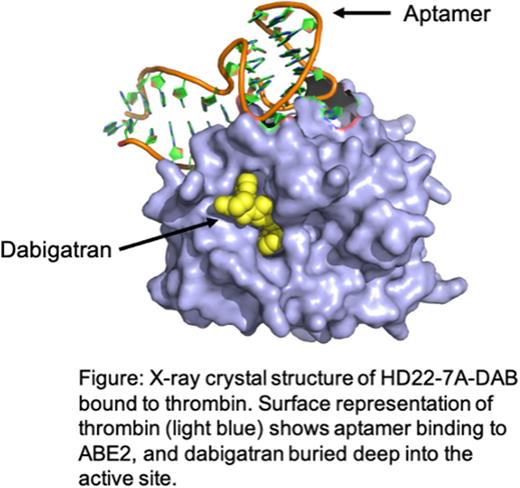Abstract
Thrombin, a serine proteinase, is the chief effector and regulator of blood coagulation. Thrombin specificity and function is modulated by liganding at the active site or two distinct anion binding exosites (ABE1, ABE2). DNA aptamer HD22 (29 nucleotides) specifically binds thrombin through ABE2 and affects functions mediated by this exosite. Dabigatran is a clinically used reversible thrombin inhibitor that binds to the active site. The combined use of aptamer and active site inhibitor has been shown to be an effective strategy to achieve potent anticoagulation in highly thrombogenic settings. This prompted the design of a heterobifunctional inhibitor by conjugating dabigatran to HD22 with a flexible oligonucleotide linker. The optimized HD22-Dabigatran conjugate (HD22-7A-DAB), containing a linker composed of 7 adenine bases, showed over 100-fold higher potency in inhibiting thrombin when compared to an equimolar mixture of HD22 and dabigatran. Here we report the x-ray structure of thrombin complexed with HD22-7A-DAB at 2.2 Å resolution. The diffraction data allows unambiguous placement of both aptamer and dabigatran moieties onto thrombin. The first 29 nucleotides forming the core of HD22 show a duplex-quadruplex hybrid motif that presents an extended molecular surface and buries 1082 Å2 of solvent accessible surface area in the interacting species. The aptamer-thrombin interface in HD22-7A-DAB is equivalent to the previously determined structure of HD22 bound to thrombin. Only 3 of the 7 adenine bases that link HD22 to dabigatran are unambiguously resolved in the structure. This implies a requirement for high flexibility in the linker for unhindered presentation of the dabigatran moiety for docking at the active site. Dabigatran is bound at the S1 specificity pocket where its amidine group is appropriately juxtaposed with Asp189. The structural model accounts for the synergistic mechanism at play in the drug-aptamer conjugate resulting from the favorable binding of the tethered ligand at the active site upon binding of the aptamer to ABE2 of thrombin. This is consistent with the finding that addition of an oligonucleotide to base pair with the linker sequence and part of HD22 to disrupt structure alleviates inhibition by HD22-7A-DAB by reversing aptamer-facilitated binding of dabigatran at the active site. This new approach, wherein aptamer binding provides added specificity and potency to deliver a tethered inhibitor to the active site in a way that can be readily reversed, provides a generalizable strategy for the potent inhibition of the other proteases in blood coagulation.
Disclosures
Sullenger:Basking Biosciences: Current equity holder in private company, Current holder of stock options in a privately-held company, Patents & Royalties: Duke Univeristy has licensed patents to Company on which I am inventor; Somalogic Inc: Consultancy. Krishnaswamy:Takeda: Consultancy; Bayer: Research Funding.
Author notes
Asterisk with author names denotes non-ASH members.


This feature is available to Subscribers Only
Sign In or Create an Account Close Modal